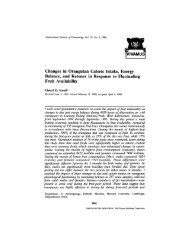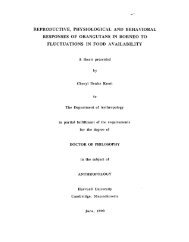Saving Gunung Palung: A Rainforest Marriage - Cheryl Knott
Saving Gunung Palung: A Rainforest Marriage - Cheryl Knott
Saving Gunung Palung: A Rainforest Marriage - Cheryl Knott
- No tags were found...
Create successful ePaper yourself
Turn your PDF publications into a flip-book with our unique Google optimized e-Paper software.
science in the field<strong>Saving</strong> <strong>Gunung</strong> <strong>Palung</strong>: A <strong>Rainforest</strong> <strong>Marriage</strong>By Susan LumenelloTheirs is a story grounded in science.He’s a biologist, she’s ananthropologist, and they startedtheir lives together while doing fieldworkin, and helping to save, a 24,000-acre Indonesian rainforest park and itsinhabitants.<strong>Cheryl</strong> <strong>Knott</strong>, an assistant professorof anthropology who earned her PhD in1999, and husband Tim Laman, a scientificassociate of the Museum ofComparative Zoology and wildlife photographerwho earned his doctorate inorganismic and evolutionary biology in1994, met as students at the GraduateSchool of Arts and Sciences in the early1990s.A decade later, <strong>Knott</strong> and Laman areproud parents of three-year-old Russelland his sister-to-be (due in December)—and they’re still working in the rainforest,studying the animal and plantlife unique to the Indonesian island ofBorneo and one of its largest nationalparks, <strong>Gunung</strong> <strong>Palung</strong> (pronounced:goo-noong paw-loong). <strong>Knott</strong> hasmade a career studying orangutans,who only live in the wild in the junglesA match made at GSAS:Tim Laman, PhD ’94,and <strong>Cheryl</strong> <strong>Knott</strong>, PhD ’99, in the rainforestcanopy of the <strong>Gunung</strong> <strong>Palung</strong> National Park.All photos in this story by Tim Laman.of Indonesia and Malaysia; Laman did hisPhD work on strangler fig trees and hasstudied a variety of creatures in the park asa field scientist for Harvard and a wildlifephotographer for National Geographic.But <strong>Gunung</strong> <strong>Palung</strong> and the 5,000-acreCabang Panti research site within it isthreatened, <strong>Knott</strong> says. Illegal logging hasdegraded large areas of the park and hasnow invaded the study site’s trail system,putting into doubt the survival of the2,500 or so orangutans that live there.According to a recent census taken by<strong>Knott</strong>’s team, that’s about ten percent ofthe world’s orangutan population; theother approximately 23,000 orangutansreside in national parks and reserves elsewhereon the islands of Borneo andSumatra.From January to February of this year,<strong>Knott</strong>, Laman, and their colleagues askedIndonesian officials for more protection ofthe site. They wanted to help governmentofficials “realize the importance of thisarea and its uniqueness,” Laman says.“Consequently there was a big patrol—thenational police force went in and clearedthe place out. Hopefully, our efforts hadsomething to do with that.”Illegal logging involves a substantialportion of the village population around<strong>Gunung</strong> <strong>Palung</strong>. “Something like twothirdsof the households in the area areinvolved in illegal logging [around thenational park],” <strong>Knott</strong> says. “That’s thousandsof people.”The good news is that the park’s forestshave not been clear-cut. The damage hasbeen “selective,” according to <strong>Knott</strong>. Thebiggest and best trees are cut, those sure tobring the best prices on the market, andsmaller trees are taken later. Still, considerabledamage is being done to the habitat.“They come in and cut an area, it getsdried out, and then it’s vulnerable to fire,”<strong>Knott</strong> says. “Once it burns, and they convertit to rice fields, then it’s going to betotally gone. We’re at a point now wherethere’s been a lot of logging, but it’s been inpockets. If it was to stop now, [the forest]could … regenerate. It would take a while,but it would be okay.”Whether that can happen depends uponstricter controls being placed on the illegalloggers. Unfortunately, the most extensivelogging is being done in the lowland forestand the peat swamp, the areas where mostorangutans live. Some can survive in thelogged areas, but it is unclear whether thepopulations are large enough to be viable.AN UPHILL BATTLELocal corruption throws a major wrenchinto the battle for the rainforest. “We’vehad very little power to do much about it,and it’s very frustrating,” Laman says.“But the scale of corruption is so great,and the powers that are involved are sostrong that, as scientists, we feel we haveso little influence. We can only try to arguethe case with Indonesian scientific agenciesand parks departments. Changing thewhole culture of corruption is … reallygoing to be long-term.”“Since the fall of [President] Suharto,there has been a lot of decentralization. Alot more control has been given to theprovinces,” <strong>Knott</strong> says. “So, even thoughthe national government wants to stop it… it’s difficult because some of the localgovernment officials—the police, the military—areinvolved in illegal logging.”The loggers who were arrested back inthe winter of this year are still awaitingtrial, according to <strong>Knott</strong>. “They have to beHarvard University2GSAS





